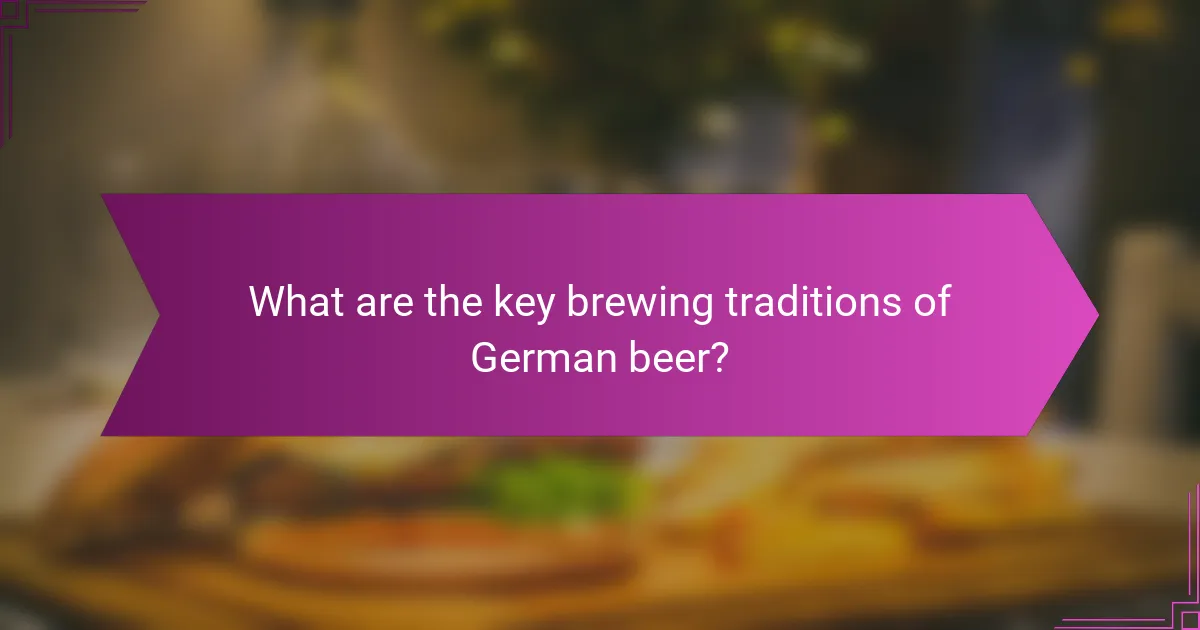German beer offers a rich tapestry of brewing traditions, unique styles, and perfect food pairings. Explore the historical significance of the Reinheitsgebot law, discover popular beer types like Pilsner and Dunkel, and learn how to enhance your dining experience with complementary flavors. This article delves into the regional diversity of German beers and emerging trends in consumption.

What are the key brewing traditions of German beer?
German beer brewing traditions emphasize purity, craftsmanship, and regional diversity. Key traditions include the Reinheitsgebot, a beer purity law from 1516, which mandates only water, barley, and hops in brewing. This law highlights the commitment to quality.
Regional styles showcase unique brewing techniques. For instance, Bavarian beers like Hefeweizen feature specific yeast strains, while Kölsch from Cologne is known for its light, crisp flavour. Each region celebrates its own festivals, such as Oktoberfest, where traditional brewing methods are honoured.
Food pairings enhance the beer experience. Rich lagers complement hearty German dishes like sausages and pretzels, while lighter ales pair well with seafood. This synergy between beer and food reflects a deep cultural appreciation for both.
Overall, German brewing traditions combine historical practices with local flavours, creating a distinct beer culture celebrated worldwide.
How do regional variations influence brewing methods?
Regional variations significantly shape brewing methods in Germany. Different regions emphasize unique ingredients and techniques, leading to diverse beer styles. For example, Bavaria is renowned for its lagers and wheat beers, while the northern regions focus on pale ales and porters. These distinctions reflect local tastes, climate, and available resources, influencing fermentation processes and flavour profiles. The adherence to the Reinheitsgebot, or beer purity law, further differentiates brewing practices across regions, ensuring quality and authenticity in German beer.
What role does the Reinheitsgebot play in brewing?
The Reinheitsgebot, or German Beer Purity Law, ensures that beer is brewed using only water, barley, and hops, preserving traditional brewing methods. This law, enacted in 1516, emphasizes quality and authenticity in German beer production. By limiting ingredients, it enhances flavour consistency and aligns with cultural heritage. Many German breweries still adhere to this law, showcasing a commitment to craftsmanship and tradition in their brewing processes.
Which ingredients are essential in traditional German beer?
The essential ingredients in traditional German beer are water, malted barley, hops, and yeast. Water quality influences taste, while malted barley provides sugars for fermentation. Hops add bitterness and aroma, and yeast ferments the sugars into alcohol. These four components are foundational in brewing various German beer styles, such as Pilsner and Weizenbier.

What types of German beer are most popular?
The most popular types of German beer include Pilsner, Weizenbier (wheat beer), Kölsch, Dunkel, and Bock. Each type offers distinct flavours and brewing traditions.
Pilsner is known for its crisp, refreshing taste and pale golden colour. Weizenbier features a fruity and spicy profile, often with banana and clove notes. Kölsch is a light, easy-drinking ale with a subtle hop aroma. Dunkel is a dark lager with rich malt flavours, while Bock is a stronger beer with a malty sweetness.
These varieties pair well with traditional German dishes. For example, Pilsner complements lighter fare like pretzels, while Dunkel pairs nicely with hearty meats.
How do lagers differ from ales in German beer culture?
Lagers differ from ales in German beer culture primarily in their fermentation process. Lagers undergo bottom fermentation at cooler temperatures, resulting in a clean, crisp taste. Ales utilize top fermentation at warmer temperatures, producing a more robust flavour profile. This distinction influences beer styles and food pairings in Germany, with lagers often complementing lighter dishes and ales pairing well with hearty meals.
Which unique styles of beer are specific to Germany?
Germany is known for its unique beer styles, including Pilsner, Weizenbier, Kölsch, and Bock. Each style reflects regional brewing traditions and ingredients.
Pilsner is a pale lager originating from the Czech Republic but popularised in Germany. Weizenbier, or wheat beer, is characterised by its fruity and spicy flavours, often served with a slice of lemon. Kölsch, a light and crisp ale from Cologne, is known for its refreshing taste. Bock is a stronger lager, rich in malt flavours, traditionally brewed for special occasions.
These styles are complemented by food pairings that enhance their distinct flavours, such as pretzels with Weizenbier and sausages with Pilsner.
What are the characteristics of German wheat beers?
German wheat beers are characterised by their fruity and spicy flavours, a cloudy appearance, and a smooth, refreshing finish. These beers are typically brewed with a high proportion of wheat, which contributes to their unique texture and flavour profile. Common attributes include a banana and clove aroma, light to medium body, and a moderate alcohol content, usually around 4.5% to 5.5%. The brewing process often involves top-fermenting yeast, which enhances the beer’s fruity characteristics. Popular styles include Hefeweizen and Witbier, each offering distinct taste experiences.

How do food pairings enhance the experience of German beer?
Food pairings significantly enhance the experience of German beer by complementing its unique flavours. Pairing traditional German dishes, such as pretzels or sausages, with specific beer types, like Hefeweizen or Pilsner, elevates both the food and beverage. The carbonation in beers can cleanse the palate, making each bite and sip more enjoyable. Additionally, the malt and hop profiles of German beers can enhance the taste of various ingredients, creating a harmonious balance. This synergy between food and beer fosters a richer tasting experience, encouraging exploration of diverse flavours.
Which traditional German dishes complement specific beer types?
Traditional German dishes pair well with specific beer types, enhancing flavours and dining experiences.
| Beer Type | Complementary Dish | Description |
|——————|——————————|———————————————|
| Pilsner | Weisswurst | Light and mild, pairs well with the crispness of Pilsner. |
| Hefeweizen | Pretzel | The fruity notes of Hefeweizen complement the saltiness of pretzels. |
| Dunkel | Sauerbraten | Rich, malty Dunkel balances the acidity of Sauerbraten. |
| Bock | Beef Goulash | The robust flavour of Bock enhances the hearty meatiness of goulash. |
| Kölsch | Flammkuchen | The lightness of Kölsch pairs nicely with the savoury toppings of Flammkuchen. |
| Märzen | Pork Knuckle (Schweinshaxe) | Märzen’s malty sweetness complements the richness of roasted pork. |
What are the best practices for pairing beer with food?
Pairing German beer with food enhances flavours and dining experiences. Consider these best practices:
1. Match beer strength with dish intensity. Light beers pair well with lighter dishes like salads, while strong beers complement hearty meals.
2. Balance flavours. Use hops to cut through richness in fatty foods, or sweet malts to match desserts.
3. Consider regional pairings. For example, Weissbier goes well with traditional German sausages, while Dunkel complements roasted meats.
4. Experiment with contrasting flavours. A sour beer can enhance the taste of rich cheeses, creating a delightful contrast.

What are the emerging trends in German beer consumption?
Emerging trends in German beer consumption include a growing preference for craft beers, increased interest in local breweries, and a shift towards low-alcohol and alcohol-free options. Consumers are prioritising quality over quantity, favouring unique flavours and sustainable brewing practices. Additionally, beer pairings with food are becoming more popular, enhancing the overall dining experience.
How is craft beer reshaping the German beer landscape?
Craft beer is significantly reshaping the German beer landscape by introducing innovative flavours and brewing techniques. Traditional German beer, known for its purity and adherence to the Reinheitsgebot, is now complemented by craft breweries that experiment with diverse ingredients and styles.
Craft breweries often emphasise local sourcing, which enhances regional identities and fosters community engagement. This shift promotes a unique attribute of craft beer: the use of unconventional ingredients like fruits, herbs, and spices, which differ from standard German beer profiles.
As a result, the craft beer movement has sparked a renewed interest in beer culture, encouraging consumers to explore food pairings that enhance the tasting experience. For instance, IPAs may pair well with spicy dishes, while stouts complement rich desserts.
Overall, craft beer is not just a trend but a transformative force that encourages innovation within Germany’s rich brewing traditions.
What role do beer festivals play in promoting German beer culture?
Beer festivals play a crucial role in promoting German beer culture by showcasing diverse brewing traditions and fostering community engagement. These events highlight the unique attributes of German beer, such as its adherence to the Reinheitsgebot, or beer purity law, and the variety of beer types, including Pilsner, Weizenbier, and Dunkel.
Attendees experience food pairings that enhance the flavours of German beer, creating a deeper appreciation for its cultural significance. Festivals often feature local breweries, allowing visitors to explore regional differences and unique brewing techniques. Additionally, educational sessions at these festivals inform participants about the history and craftsmanship behind German beer, reinforcing its status as a cultural heritage.
Overall, beer festivals serve as vibrant platforms for celebrating and promoting the rich traditions of German beer, connecting brewers and enthusiasts alike.
How are sustainability practices influencing German breweries?
Sustainability practices are significantly influencing German breweries by promoting eco-friendly production methods. Many breweries are adopting renewable energy sources, reducing water usage, and implementing recycling programs. These changes enhance brand reputation and appeal to environmentally conscious consumers. As a result, traditional brewing methods are being adapted to meet modern sustainability standards, ensuring the longevity of Germany’s rich beer culture.
What are common mistakes to avoid when enjoying German beer?
To enjoy German beer fully, avoid common mistakes such as drinking it too cold, which masks flavours. Another mistake is not pairing it correctly with food; for instance, lighter beers complement seafood better than heavier dishes. Failing to appreciate the specific styles, like Hefeweizen or Pilsner, can detract from the experience. Lastly, neglecting to learn about the brewing traditions may limit your understanding and enjoyment of the beer’s unique attributes.



